How Transactional Emails Add Value to Your Lifecycle Marketing
Het zijn de saaie dingen die er het meest toe doen.
Broccoli is niet aantrekkelijk, maar het geeft je de broodnodige calcium en vezels.
Squats lijken alledaags en repetitief op de beendag, maar je zult sterker worden.
Dit principe geldt ook voor e-mailmarketing.
Marketing e-mails zijn leuk en soms flitsende, maar het zijn de over het hoofd geziene transactionele e-mails die waarde toevoegen aan uw levenscyclusmarketing .
Volgens een studie van IBM Marketing Cloud worden transactionele e-mails meer dan twee keer zo vaak geopend als niet-transactionele e-mails . Transactionele e-mails hebben bovendien een gemiddelde klikfrequentie van 4,8%, precies drie keer hoger dan niet-transactionele berichten.
Met dat gezegd, is het tijd om transactionele e-mails uw onverdeelde aandacht te geven. Ze hebben de sleutel tot klantenbehoud.
Laten we de waarde achter transactionele e-mails verkennen en bekijken hoe uw team hiervan de vruchten kan plukken.
Het leveren van continue waarde
In de eenvoudigste vorm is e-mailmarketing een communicatiekanaal voor uw bedrijf om contact te leggen met klanten. Je primaire doel is om je publiek te informeren.
However, over the years, email has transformed into an outlet to constantly sell to customers. On any given day, a buyer’s inbox contains three to five emails attempting to persuade him to purchase products.
This ongoing sales pitch annoys customers (especially if none of the products fit their needs). As a result, consumers ignore these messages or worse, hit the spam button.
Email marketing isn’t supposed to be like a random pop-up ad or a sleazy used car salesman. Rather, its purpose is to deliver continuous value to the customer.
And that’s why transactional emails earn higher open and click-through rates. They inherently give value to email recipients.
While industry experts define transactional emails differently, the CAN-SPAM Act offers a broad definition:
Transactional email: facilitates an already agreed-upon transaction or updates a customer about an ongoing transaction
These lifecycle messages can extend from welcome emails to subscription invoices to password reset emails. When customers receive these emails, they expect a high level of value.
For instance, when customers make a purchase, they anticipate an order confirmation email. And once received, they feel reassured about making the purchase.
Transactional emails keep the customer relationship alive. Justin Hieggelke, Customer.io’s vice president of sales, offers his perspective:
“Transactional messages provide an instrumental connection between the brand and the confirmation of value received. They create confidence, anticipation, and a connection between the user and the brand’s value exchange."
Your team can bridge the gap between the customer and your brand. The starting point is understanding the value within your transactional emails.
Strategy Over Tactics
In lifecycle marketing, shiny object syndrome is a real thing. Your team can get quickly bogged down by every new tactic in the market.
You can either obsess over the color of your call-to-action button, or you can turn your attention to making big moves in your strategy. Of course, we recommend the latter.
For transactional email campaigns, this process involves evaluating how each message correlates with your customers’ behaviors and then using those existing behaviors to improve the customer relationship and your revenue goals.
Let’s say every time Mary buys a product from your brand she expects an email receipt. So her natural instinct is to check her inbox.
Mary also doesn’t like sifting through multiple pages to find products that fit her needs. She would rather someone give her suggestions.
In this case, upselling or cross-selling in your transactional emails can help customers like Mary discover more value in your brand.
One solution is to send Mary an email receipt that includes targeted product recommendations. Mary is happy because she gets her receipt and suggestions without adapting any new behaviors. Your team wins by adding another revenue opportunity to an existing channel.
This strategy works across several industries. Jordie van Rijn, an independent email marketing consultant and industry influencer, gives his viewpoint:
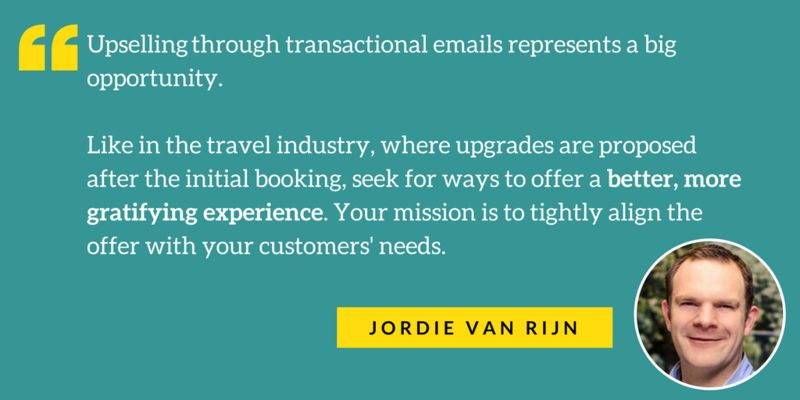
While it’s tempting to concentrate on arbitrary tactics, you’ll benefit more by building a sound strategy around your transactional email campaigns. Focus on customer behavior, then insert a path to achieve your desired goal.
Transactional Emails in Action
Strategy is dead without action. So don’t let your plans get accidently deleted in an unnamed folder on your desktop. Make a deliberate effort to execute your strategies. Below are a few examples of how transactional emails can serve your customers and your company.
In-App Alerts
Every user needs a nudge in the right direction. In-app notifications empower the user to engage with your application. It serves as a reminder for the user and creates an essential habit-forming behavior.
Makers Academy regains the attention of their users with an in-app notification. This transactional email points out that the person hasn’t completed his application. With a bold call to action, the user feels enticed to log back into the platform.
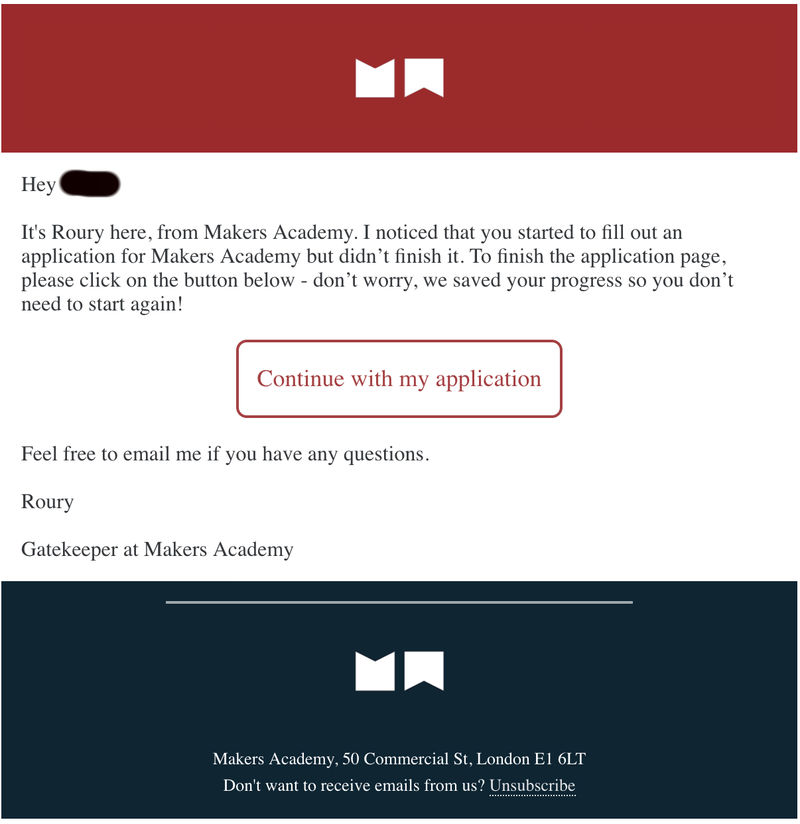
Referral Emails
Satisfied customers sit on the front lines of brand advocacy. They possess the zeal to spread the good news about your product. Your team’s responsibility is to give them the tools to make the magic happen.
Referrals emails help facilitate your advocacy efforts. Sticker Mule shares the reasoning for their email with guidance on how to participate in their referral program. Plus, their customers gain something in return.
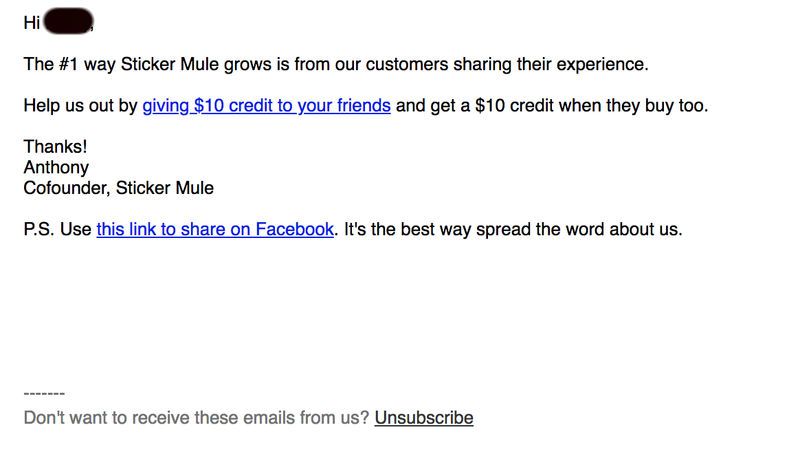
Invoices
Payment collection dates back to ancient civilization. A timely invoice notifies customers about their purchases and the amount owed. It also is a strategy to improve your cash flow.
G Suite provides a straightforward invoice. It informs the customer that the balance will be automatically charged. This transactional email also offers clear-cut instructions on how to update payment information.
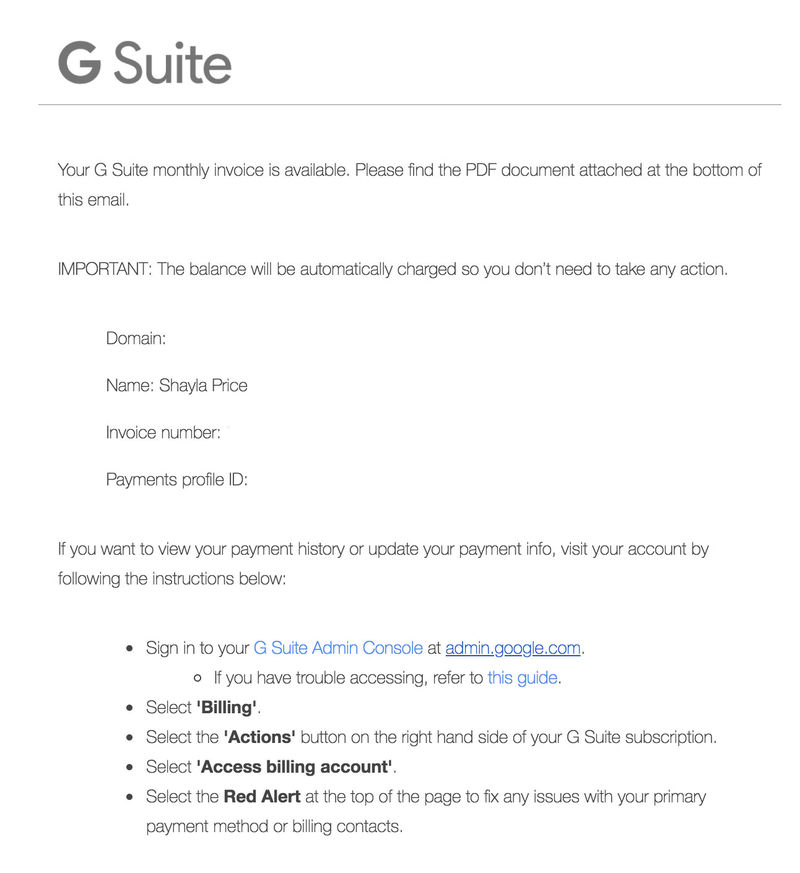
Privacy Policy Notices
A message full of legal jargon is probably the last thing your customers want from you. But it’s part of doing business.
Privacy policy notices inform your audience on how you collect, use, and retain their personal information. The image below shows the top portion of a transactional email from Ally. The financial institution uses a serious tone combined a method for the customer to take further action.
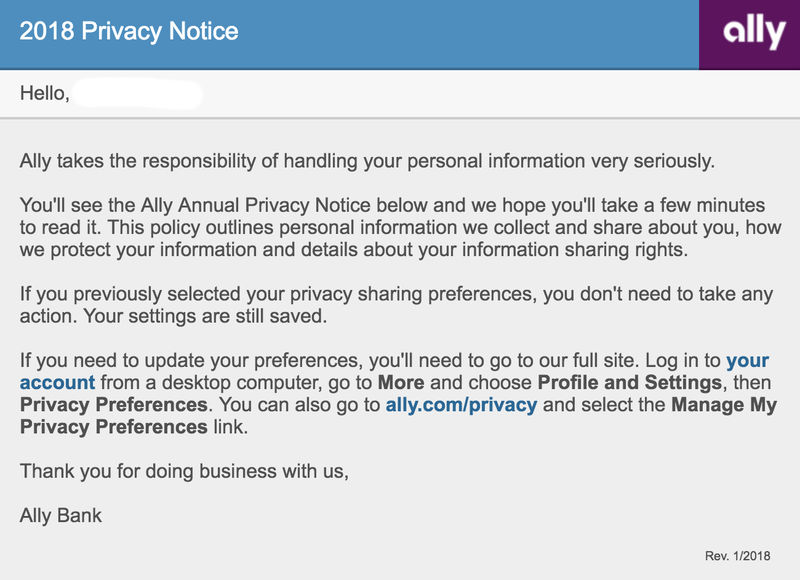
Optimizing Your Transactional Emails
Once your strategy is in motion, it’s easy to put your transactional emails on autopilot. But that doesn’t help your customers or your quarterly goals.
It’s important that you continue to optimize your messages beyond inception. Yes, this process may involve A/B testing your subject lines, copy length, or even your timing.
But as a smart marketer, you want to go the extra mile. Try optimizing for value.
You can start by analyzing how a specific transactional email fits into the customer lifecycle. What is the customer’s mindset? What do they hope to achieve? How can you exceed their expectations?
For example, a welcome email serves as the first email new customers receive from your brand. These customers may be hungry for more details about your company or want more reasons to stick around.
In this type of transactional email, you’ll want to highlight your value proposition, answer any lingering questions, and add a call to action for them to experience your brand.
You’ll also want to understand how your recipients engage with your emails. With the boom in mobile devices, every customer isn’t reading emails from their desktop computer at home.
Email Client Market Share data uncovers that mobile devices is still the most popular reading environment for email. Jaina Mistry, an email marketing specialist at Litmus, offers her expert advice:
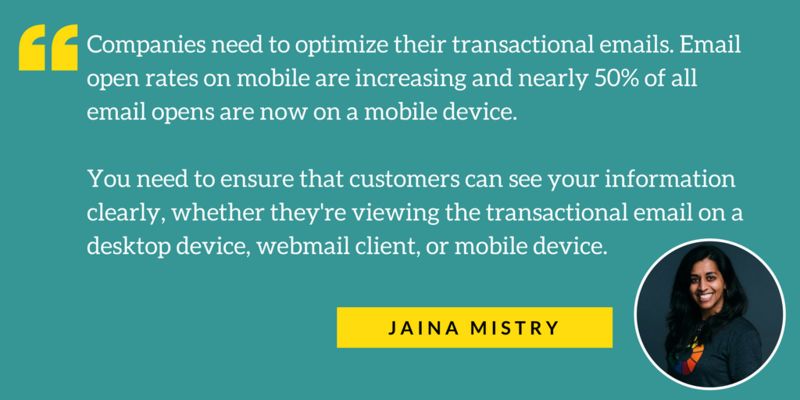
Improving your transactional emails is an opportunity for your team. When you optimize for value, you’re optimizing for a better customer experience. And happy customers lead to retention.
Adding Value to the Inbox
Transactional emails play an integral role in your lifecycle marketing. Customers want to see value in every message, whether it’s a privacy policy notice or an order confirmation email. So take bold steps toward making your transactional emails valuable.
How can transactional emails bring value to your customers? Write your comments below!
Stay ahead of the curve with weekly updates
Get fresh insights about user engagement, email marketing,
and copywriting to grow your business. Sign up for the newsletter today!
Neem contact op
- © 2012-2018 Peaberry
Source: customer.io

